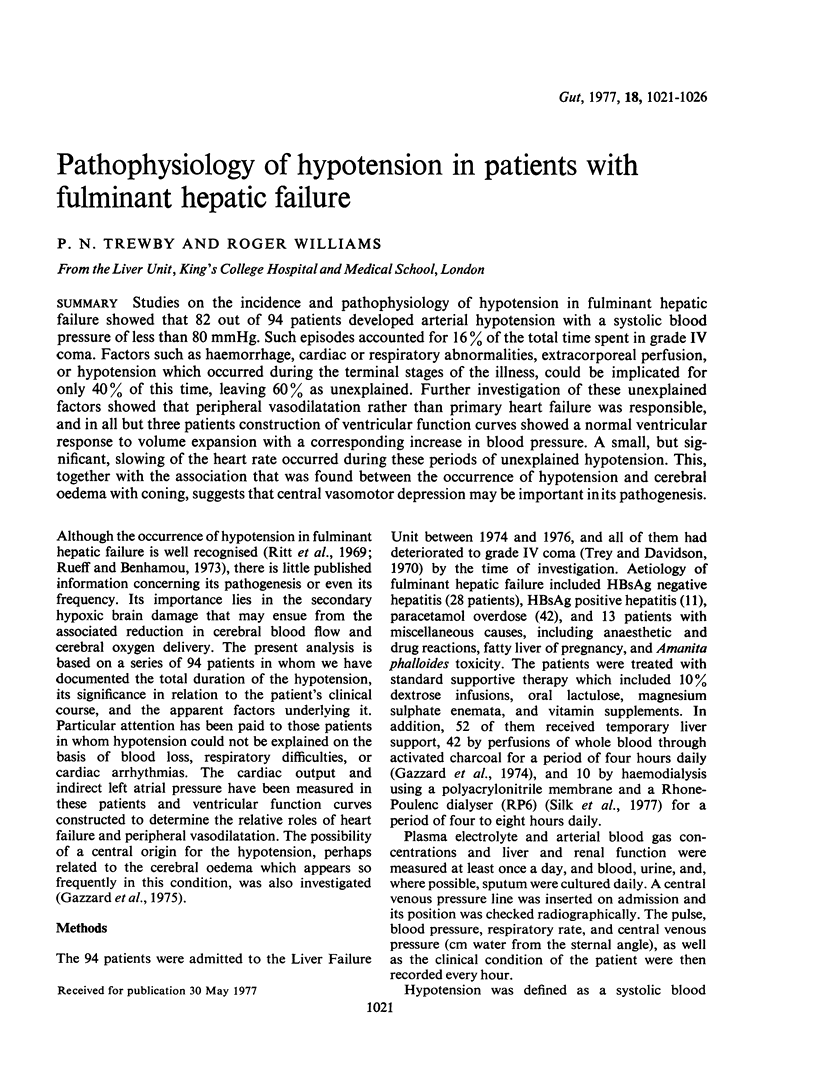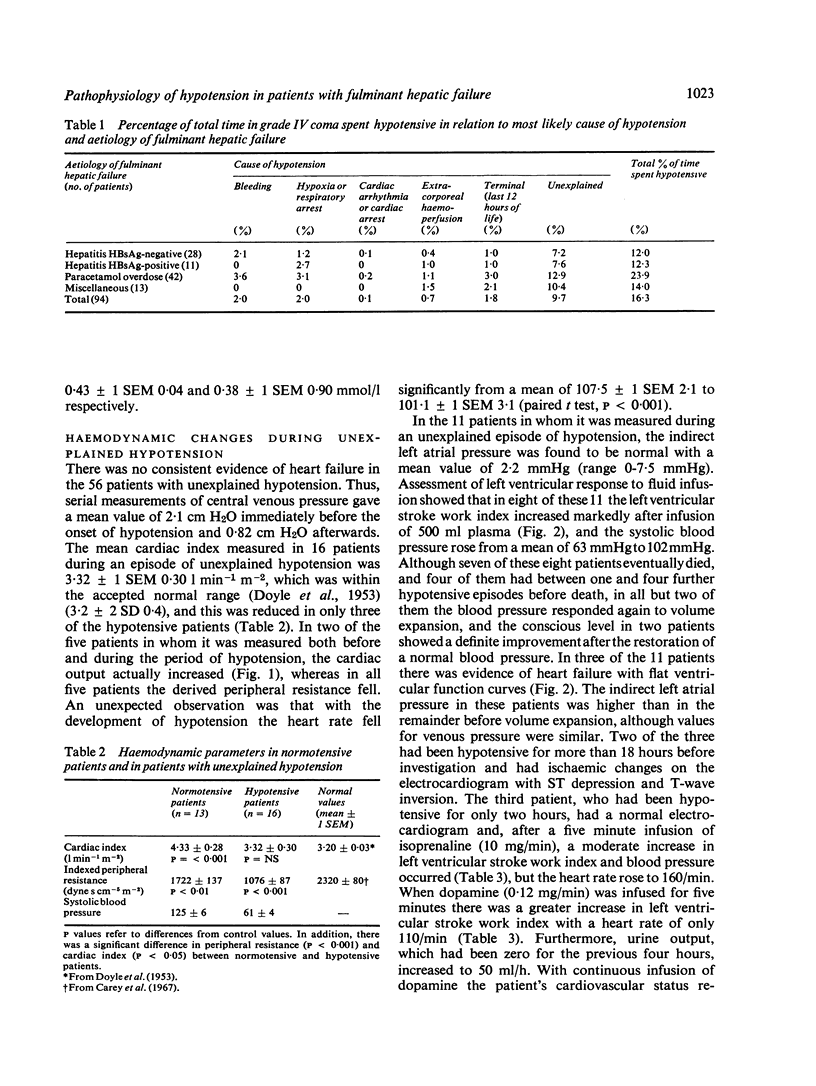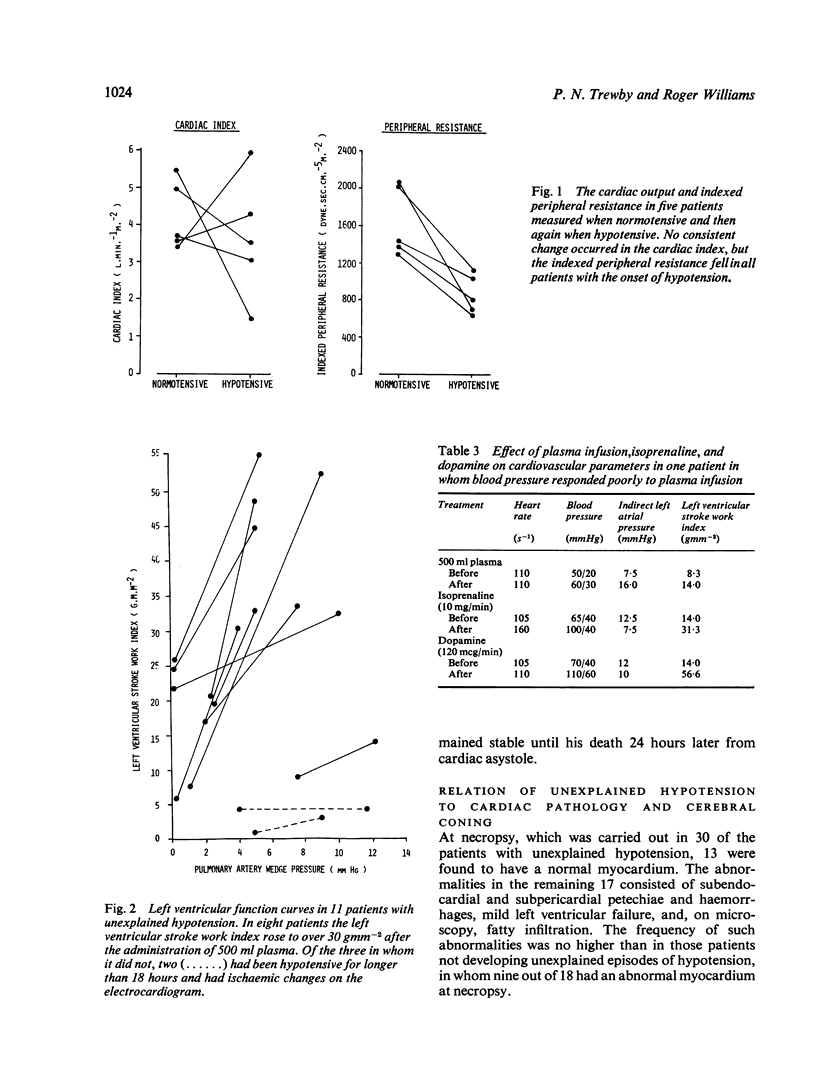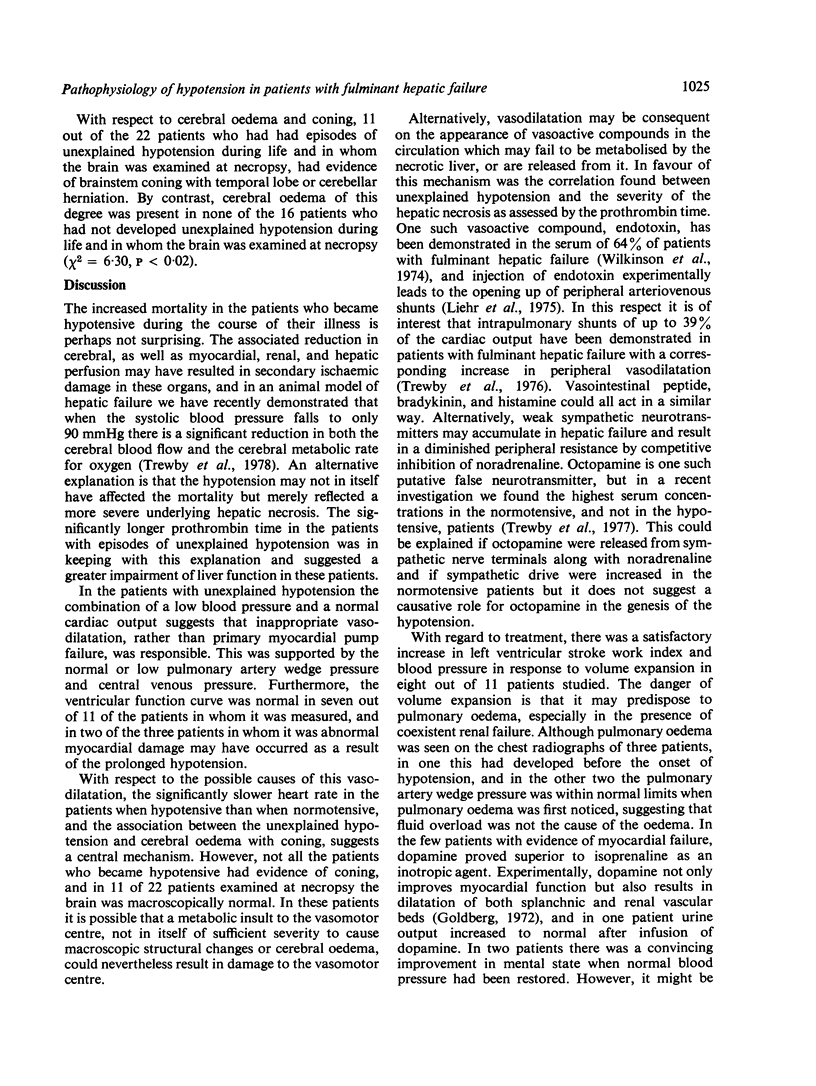Abstract
Studies on the incidence and pathophysiology of hypotension in fulminant hepatic failure showed that 82 out of 94 patients developed arterial hypotension with a systolic blood pressure of less than 80 mmHg. Such episodes accounted for 16% of the total time spent in grade IV coma. Factors such as haemorrhage, cardiac or respiratory abnormalities, extracorporeal perfusion, or hypotension which occurred during the terminal stages of the illness, could be implicated for only 40% of this time, leaving 60% as unexplained. Further investigation of these unexplained factors showed that peripheral vasodilatation rather than primary heart failure was responsible, and in all but three patients construction of ventricular function curves showed a normal ventricular response to volume expansion with a corresponding increase in blood pressure. A small, but significant, slowing of the heart rate occurred during these periods of unexplained hypotension. This, together with the association that was found between the occurrence of hypotension and cerebral oedema with coning, suggests that central vasomotor depression may be important in its pathogenesis.
Full text
PDF





Selected References
These references are in PubMed. This may not be the complete list of references from this article.
- Carey J. S., Brown R. S., Mohr P. A., Monson D. O., Yao S. T., Shoemaker W. C. Cardiovascular function in shock. Responses to volume loading and isoproterenol infusion. Circulation. 1967 Feb;35(2):327–338. doi: 10.1161/01.cir.35.2.327. [DOI] [PubMed] [Google Scholar]
- DOYLE J. T., WILSON J. S., LEPINE C., WARREN J. V. An evaluation of the measurement of the cardiac output and of the so-called pulmonary blood volume by the dye-dilution method. J Lab Clin Med. 1953 Jan;41(1):29–39. [PubMed] [Google Scholar]
- Ganz W., Swan H. J. Measurement of blood flow by thermodilution. Am J Cardiol. 1972 Feb;29(2):241–246. doi: 10.1016/0002-9149(72)90635-2. [DOI] [PubMed] [Google Scholar]
- Gazzard B. G., Portmann B., Murray-Lyon I. M., Williams R. Causes of death in fulminant hepatic failure and relationship to quantitative histological assessment of parenchymal damage. Q J Med. 1975 Oct;44(176):615–626. [PubMed] [Google Scholar]
- Gazzard B. G., Weston M. J., Murray-Lyon I. M., Flax H., Record C. O., Williams R., Portmann B., Langley P. G., Dunlop E. H., Mellon P. J. Charcoal haemoperfusion in the treatment of fulminant hepatic failure. Lancet. 1974 Jun 29;1(7870):1301–1307. doi: 10.1016/s0140-6736(74)90678-3. [DOI] [PubMed] [Google Scholar]
- Goldberg L. I. Cardiovascular and renal actions of dopamine: potential clinical applications. Pharmacol Rev. 1972 Mar;24(1):1–29. [PubMed] [Google Scholar]
- Liehr H., Grün M., Thiel H., Brunswig D., Rasenack U. Endotoxin-induced liver necrosis and intravascular coagulation in rats enhanced by portacaval collateral circulation. Gut. 1975 Jun;16(6):429–436. doi: 10.1136/gut.16.6.429. [DOI] [PMC free article] [PubMed] [Google Scholar]
- Ritt D. J., Whelan G., Werner D. J., Eigenbrodt E. H., Schenker S., Combes B. Acute hepatic necrosis with stupor or coma. An analysis of thirty-one patients. Medicine (Baltimore) 1969 Mar;48(2):151–172. doi: 10.1097/00005792-196903000-00003. [DOI] [PubMed] [Google Scholar]
- Rueff B., Benhamou J. P. Acute hepatic necrosis and fulminant hepatic failure. Gut. 1973 Oct;14(10):805–815. doi: 10.1136/gut.14.10.805. [DOI] [PMC free article] [PubMed] [Google Scholar]
- Silk D. B., Trewby P. N., Chase R. A., Mellon P. J., Hanid M. A., Davies M., Langley P. G., Wheeler P. G., Williams R. Treatment of fulminant hepatic failure by polyacrylonitrile-membrane haemodialysis. Lancet. 1977 Jul 2;2(8027):1–3. doi: 10.1016/s0140-6736(77)90001-0. [DOI] [PubMed] [Google Scholar]
- Trewby P. N., Chase R. A., Davis M., Williams R. The role of the false neurotransmitter octopamine in the hypotension of fulminant hepatic failure. Clin Sci Mol Med. 1977 Mar;52(3):305–310. doi: 10.1042/cs0520305. [DOI] [PubMed] [Google Scholar]
- Trey C., Davidson C. S. The management of fulminant hepatic failure. Prog Liver Dis. 1970;3:282–298. [PubMed] [Google Scholar]
- Wilkinson S. P., Arroyo V., Gazzard B. G., Moodie H., Williams R. Relation of renal impairment and haemorrhagic diathesis to endotoxaemia in fulminant hepatic failure. Lancet. 1974 Mar 30;1(7857):521–524. doi: 10.1016/s0140-6736(74)92711-1. [DOI] [PubMed] [Google Scholar]


